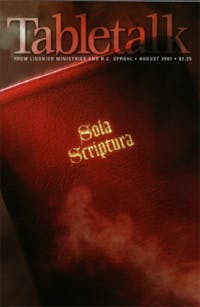
Request your free, three-month trial to Tabletalk magazine. You’ll receive the print issue monthly and gain immediate digital access to decades of archives. This trial is risk-free. No credit card required.
Try Tabletalk NowAlready receive Tabletalk magazine every month?
Verify your email address to gain unlimited access.
Dr. Keith Mathison’s third published work, The Shape of Sola Scriptura, was written to achieve two goals: to “clear away … misleading historical and theological rhetoric” encompassing the doctrine of sola Scriptura and “to outline a consistent doctrine of the authority of Scripture.” Absorbing? Yes, it is. Necessary? Yes, it is, because the doctrine of sola Scriptura is so frequently misunderstood.
In the first section of this almost 350-page work, Mathison aims to define the one-source view of revelational authority that held sway in the early church. He identifies this teaching as the view of the Reformers, and explains that it is the position they defended against the two-source view of authority, which arose during the time of Basil in the fourth century. Additionally, the pervasive evangelical doctrine of “solo Scriptura,” an exceedingly individualistic and relativistic standard of authority, is addressed and compared with the teaching of the historically orthodox position.
It is well-demonstrated in the book that Scripture is identified in Scripture as a cohesive whole, “our sole God-breathed authority,” and therefore our only infallible authority. Sola Scriptura, as defined by Scripture, is not a rejection of tradition or of the subordinate authority of the church. It is a rejection of relativistic individualism, the two-source view of revelation, and other views that are not founded on Scripture or are a distortion of the Biblical formula of interpretation and authority.
Defending sola Scriptura on multiple fronts, Mathison demonstrates that the two-source theory of Roman Catholicism, the mystical view of tradition described by Eastern Orthodoxy, and the relativism of many contemporary evangelicals are untenable and result in either “institutional or individual autonomy.” Scripture is the one final, authoritative, inspired, normative, and ecclesiastical standard, but there are subordinate and inferior authorities such as creeds, councils, and community that do not contradict sola Scriptura.
The author explains many common misconceptions about the practicality of sola Scriptura in response to critical arguments and objections. And he very clearly investigates the development of the doctrine without the use of technical jargon, allowing the reader to understand the issue simply.
This book is engaging and interesting, and it addresses the ultimate issue of authority for the Christian in the context of church history and redemption.
The Shape of Sola Scriptura is published by Canon Press.
